2.6 Grammar: Gender and Number
Gender
Instructor Video: Gender in Urdu
In Urdu, nouns can be divided into two types of gender, namely مزکر “Masculine” and مؤنش “Feminine”. Like English, Urdu has social gender such as boy and girl/man and woman. However, unlike English, Urdu also has grammatical gender. For example: Book, table, etc, are “feminine” nouns. Whereas, room, house, door, etc. are “masculine” nouns.
There are no certain rules to learn about gender assignment to particular noun in Urdu. Based on common observation, masculine and feminine nouns can be further classified into two subcategories as shown in the following table (1).
| Masculine | Feminine | |
| Marked (Type 1) | Nouns that end in -ا/ہ “-aa”. | Nouns that end in -ی “-i/ii”. |
| Examples | لڑکا laRakaa “boy”
کمرا kamaraa “room” بچہ bachchaa “boy child” دروازہ darawaazaa “door” |
لڑکی laRakii “girl”
بچی bachchii “girl child” کھڑکی khiRakii “window” کرسی kursii “chair” |
| Unmarked (Type 2) | Nouns that do not end in -ا/ہ “-aa”. | Nouns that do not end in -ی “-i/ii“. |
| Examples | گھر ghar “home”
پھل phal “fruit” سیب seb “apple” کتب خانہ kutubkhana “library” |
کتاب kitaab “book”
میز mez “table” تصویر taswiir “picture” قمیض kamiiz “shirt” |
Table 1. Sub-Categories of Masculine and Feminine Gender
These rules have multiple exceptions such as:
Nouns ending in -ا/ہ “-aa”, but feminine.
- لتا lataa “leaf,”
- گھٹا ghaTaa “cloud”
- دوا dawaa “medicine”, etc.
Nouns ending in -ی “-i/ii”, but masculine.
- ساتھی saathii “Friend”.
- ہاتھی hathii “Elephant”.
Test Yourself
Number
Instructor Video: Singular to Plural Number in Urdu
Like English, Urdu has two numbers, namely, singular number and plural number. To change singular nouns into plurals in Urdu, it is important to know the gender of the nouns and apply the following rules.
- All marked masculine nouns (that end in -ا/ہ “-aa”) change into -ے “-e”.
- Unmarked masculine nouns (that do not end in -ا/ہ “-aa”) do not change their form in plural.
- All marked feminine nouns (that end in -ی/یی “i/ii”) change into -یاں “-iyan”.
- Unmarked feminine nouns (that do not end in -ی/یی “i/ii”) change into -یں “-yen”.
The following table (2) summarizes these rules and shows examples.
|
|
Masculine |
Feminine |
|
Marked (Type 1) |
Nouns that end in -آ “-aa” |
Nouns that end in -ی/یی “-i/ii” |
|
Rule for plural |
change -آ “-aa” into -ے “-e” |
change -ی/یی “-i/ii” into -یاں “-iyan” |
|
Examples |
“boys” لڑکا – لڑکے “rooms” کمرہ – کمرے “boy children” بچہ – بچے “doors” دروازہ – دروازے |
“girls” لڑکی – لڑکیاں “girl children” بچی – بچیاں “windows” کھڑکی – کھڑکیاں “chairs” کرسی – کرسیاں |
| Unmarked (Type 2) | Nouns that do not end in -آ “-aa” | Nouns that do not end in -ی/یی “-i/ii“ |
| Rule for plueal | No changes in form | change into -یں “-yen” |
| Examples |
“homes” گھر – گھر “fruits” پھل – پھل “apples” سیب – سیب “mangoes” آم – آم |
“books” کتاب – کتابیں “tables” میز – میز یں “pictures” تصویر – تصویریں “shirts” قمیض – قمیضیں |
Table 2. Summary of rules for changing singular nouns to plural based on the sub-categories of masculine and feminine gender.
Test Yourself
Vocabulary 5. Names of Fruits and Vegetables
“Names of Fruits” پھلوں کے نام |
||
 |
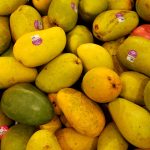 |
 |
| (m) apple سیب | (m) mango آم | (m) banana کیلا |
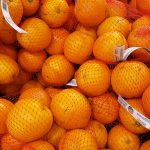 |
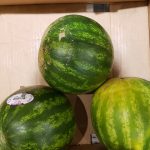 |
 |
| (m) orange سنترا | (m) watermelon تربوز | (m) pineapple انناس |
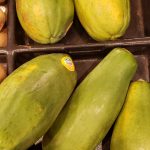 |
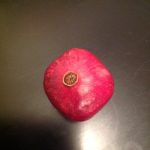 |
 |
| (m) papaya پپیتا | (m) pomegranate انار | (m) grapes انگور |
“Names of Vegetables” سبزیوں کے نام |
||
 |
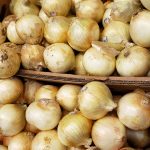 |
 |
| (m) potato آلو | (m) onion پیاز | (m) tomato ٹماٹر |
 |
 |
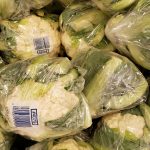 |
| (m) spinach پالک | (m) peas مٹر | (f) cauliflower پھول گوبھی |
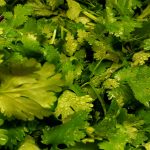 |
 |
 |
| Cilantro دھنیا | (f) cabbage پتا گوبھی | (m) egg plant بینگن |
 |
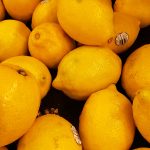 |
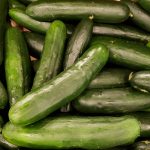 |
| (f) bell pepper شملہ مرچ | (m) lemon لیموں | (m) cucumber کھیرا |
Test Yourself
True/False
Vocabulary Test
!شکریہ

